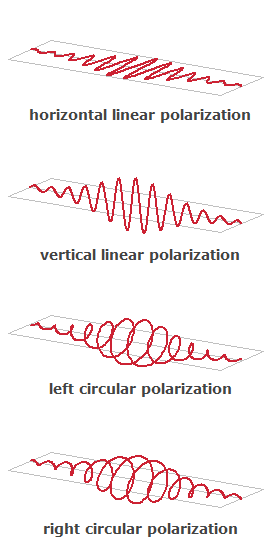Polarization of Laser Emission
Definition: direction of the electric field oscillation of a laser beam
German: Polarisation der Laseremission
In many, although not all, cases the output of a laser is polarized. This normally means a linear polarization state, where the electric field oscillates in a certain (stable) direction perpendicular to the propagation direction of the laser beam. There are cases (occurring e.g. with fiber lasers) where a different, e.g. elliptical but also more or less stable polarization state is generated, which can be transformed into a linearly polarized beam, e.g. by using an appropriate combination of waveplates. This is not possible, however, for broadband emission with wavelength-dependent polarization state.

Under special circumstances, radially polarized beams can be generated, where the polarization direction within the beam profile is radially oriented. Usually, a radially polarized beam is generated from a linearly polarized beam with some optical element, but it is also possible to obtain radially polarized emission directly from a laser. The advantage of this approach, applied in a solid-state bulk laser, is that depolarization loss may be avoided [4].
Polarized laser emission is important for a range of applications. Some examples are:
- nonlinear frequency conversion, where phase matching in a nonlinear crystal is normally obtained only for one polarization direction
- cases where two laser beams need to be polarization-coupled (→ polarization beam combining)
- processing of laser beams in polarization-dependent devices, such as interferometers, semiconductor optical amplifiers, and optical modulators
However, some lasers (e.g. many fiber lasers) do not generate a polarized output. This does not necessarily mean that the laser output is truly unpolarized, containing equal optical powers in two polarization components at any time, without any correlation of the corresponding amplitudes. The polarization state may simply be unstable, e.g. due to temperature drifts, or randomly switch between different directions. For generating a truly unpolarized laser beam, some kind of polarization-scrambling optical device is usually required.
The degree of linear polarization is often quantified with the polarization extinction ratio (PER), defined as the ratio of optical powers in the two polarization directions, often specified in decibels, and measured by recording the orientation-dependent power transmission of a polarizer. Of course, the extinction ratio of the polarizer itself must be higher than that of the laser beam.
Mechanisms for Polarized or Unpolarized Emission
Different mechanisms can be responsible for linearly polarized emission of a laser:
- The laser gain may be polarization dependent. This is the case in some anisotropic laser crystals (e.g. Nd:YVO4 or Nd:YLF), but also in some semiconductor optical amplifiers.
- The resonator losses may be polarization dependent, e.g. when the resonator contains a Brewster plate or even only a slightly tilted optical component.
Note that a very small gain or loss difference for the two polarization directions can be sufficient for obtaining a stable linear polarization, provided that there is no significant coupling of polarization modes within the laser resonator.
On the other hand, the polarization state of the laser output can be disturbed e.g. by random (and temperature-dependent) birefringence, such as occurs e.g. in optical fibers (if they are not polarization-maintaining or single-polarization fibers) and also in laser crystals or glasses as a result of thermal effects (→ depolarization loss). If the laser gain is isotropic, small drifts of the birefringence may lead to large changes of the polarization state, and also a significant variation in the polarization state across the beam profile.
Bibliography
| [1] | V. G. Niziev and A. V. Nesterov, “Influence of beam polarization on laser cutting efficiency”, J. Phys. D 32 (13), 1455 (1999) |
| [2] | A. V. Nesterov and V. G. Niziev, “Laser beams with axially symmetric polarization”, J. Phys. D 33 (15), 1817 (2000) |
| [3] | Q. Zhan, and J. Leger, “Focus shaping using cylindrical vector beams”, Opt. Express 10 (7), 324 (2002) |
| [4] | I. Moshe et al., “Production of radially or azimuthally polarized beams in solid-state lasers and the elimination of thermally induced birefringence effects”, Opt. Lett. 28 (10), 807 (2003) |
| [5] | ISO Standard 12005, “Lasers and laser-related equipment – Test methods for laser beam parameters – Polarization” |
| [6] | Q. Zhan, “Cylindrical vector beams: from mathematical concepts to applications”, Advances in Optics and Photonics 1 (1), 1 (2009) |
| [7] | M. Rumpel et al., “Circular grating waveguide structures for intracavity generation of azimuthal polarization in a thin-disk laser”, Opt. Lett. 37 (10), 1763 (2012) |
See also: birefringence, lasers, fibers, depolarization loss, polarization beam combining, polarizers, Spotlight article 2008-04-28, Spotlight article 2012-03-03
and other articles in the categories general optics, lasers



If you like this page, please share the link with your friends and colleagues, e.g. via social media:
These sharing buttons are implemented in a privacy-friendly way!